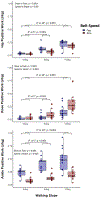Asymmetric walking on an incline affects aspects of positive mechanical work asymmetrically
- PMID: 35413513
- PMCID: PMC9428932
- DOI: 10.1016/j.jbiomech.2022.111083
Asymmetric walking on an incline affects aspects of positive mechanical work asymmetrically
Abstract
The purpose of this study was to determine the extent to which we could use a split-belt experimental paradigm to increase limb or joint work. Split-belt treadmill walking was combined with uphill walking at 0°, 5° and 10° in young, healthy individuals to assess whether we could specifically target increased force output between and within limbs. Thirteen healthy, young adults participated in this study. Participants performed walking trials with the left belt at 1.0 m/s and the right belt at 0.5 m/s. Repeated measures ANOVAs assessed the effects of speed of the treadmill belt and incline on total and joint specific positive extensor work as well as relative work. Mechanical work varied because of the speed and incline of the treadmill belt at the level of the total limb and across joints. Positive lower extremity relative joint work varied as a result of treadmill belt speed and treadmill incline. Positive mechanical work was greater on the limb that was on the faster treadmill belt, regardless of incline. Increases in relative knee but not hip joint work increased as incline increased. The current investigation shows that the nervous system can shift mechanical work production both between and within limbs to safely walk in a novel split-belt environment. This work extends previous research by demonstrating that researchers/clinicians can also use increasing treadmill incline (or some other means to add increased resistive forces) during split-belt treadmill walking to encourage increased mechanical output at particular limbs and/or joints which may have rehabilitation implications.
Keywords: Joint work; Kinetics; Split-belt treadmill; Walking.
Copyright © 2022 Elsevier Ltd. All rights reserved.
Conflict of interest statement
Declaration of Competing Interest
The authors declare that they have no known competing financial interests or personal relationships that could have appeared to influence the work reported in this paper.
Figures




References
-
- Conway KA, Bissette RG, Franz JR, 2018. The Functional Utilization of Propulsive Capacity During Human Walking. J. Appl. Biomech 1–31. - PubMed
-
- Haight DJ, Lerner ZF, Board WJ, Browning RC, 2014. A comparison of slow, uphill and fast, level walking on lower extremity biomechanics and tibiofemoral joint loading in obese and nonobese adults. J. Orthop. Res 32, 324–330. - PubMed
-
- Holden JP, Chou G, Stanhope SJ, 1997. Changes in knee joint function over a wide range of walking speeds. Clin. Biomech. (Bristol, Avon) 12, 375–382. - PubMed
Publication types
MeSH terms
Grants and funding
LinkOut - more resources
Full Text Sources

